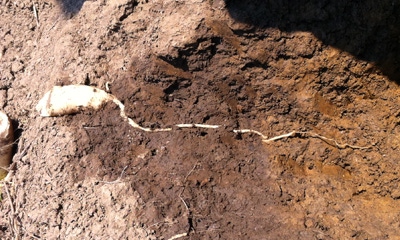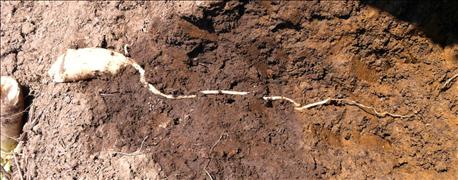
Why plant cover crops? It seems like a simple question, and Susannah Hinds usually gives a lengthy answer. Hinds is a grazing specialist with the Natural Resources Conservation Service in Indiana.
She is also proud to be part of the Indiana Conservation Partnership. Personnel from the partnership helped provide an answer to this question, plus information on other soil conservation topics.
The benefits you seek really make a difference when picking the cover crop species you will plant, Hinds says. Do you want to break up a compaction layer? Then she recommends you select a species with deep roots or large amounts of root biomass. Picture the deep tubers of radishes.

GO LONG! In this case, the more correct terminology would be "go deep." This radish root from a fall-planted forage radish cover crop penetrates deep into the soil. (Photo courtesy of Kris Vance, NRCS)
Radish roots can run deep, as illustrated here. They can punch through compacted soil.
If you want to increase soil organic matter, select species that will produce high volumes of organic material, will survive winter and will grow quickly in the spring. These need to be planted early and terminated as late as practical in the spring to maximize vegetation, Hinds says.
Examples are crimson clover and annual ryegrass.
Legumes will add nitrogen. Brassicas and many grasses will store excess nitrogen. Complex mixes of cover crops have complex benefits, but also may require more planning for termination.
Hinds says knowing what you want to affect will help determine what you plant. Keep in mind termination opportunities and challenges when making your selections.
Get 'snirt-y' about soil and no-till
“Snirt” is the combination that results from snow mixing with dirt. Most people see this piled high in the corners of parking lots. However, in the cold winter months, snirt can also be prevalent in fields, Shannon Zezula says. He is the state resource conservationist with NRCS.
In conventionally tilled fields, snow drifts and leaves behind both bare soil and large mounds of snow. Moisture leaves the soil in some areas and overaccumulates in others. The higher piles of snow can delay crop growth.
Snow piles also lead to more wet patches in the spring. Snow blowing across conventionally tilled soils collects dirt, turning it into snirt. When those large snow piles melt, soil erosion is promoted.
In no-till fields, the taller residue — whether it be in the form of tall cornstalks, bean stubble or fresh cover crop growth — keeps snow uniformly in place and insulates the soil from water evaporation. This aids in higher yields and reduces the amount of valuable soil removed from fields.
Soil compaction
As farm machinery increases in size, an unseen problem may occur. The weight of the tractors, grain carts, combines and other equipment may cause compaction issues. Clint Harrison, a district conservationist with NRCS, says an easy way to determine if soil is suffering from compaction is to actually look at the soil by taking a soil profile with a spade or a probe. Compacted soil will have a platy, compressed soil structure. If the topsoil has compaction issues, machinery is most likely to blame.
Ways to avoid soil compaction include making sure tires are properly inflated, using flotation tires, reducing tillage and staying out of the field if it is wet. If soil compaction is present in the subsoil, using controlled traffic lanes in the field may be beneficial.
Harrison recommends considering planting cover crops, as they can be useful in reducing compaction. Roots of cover crops can also help with improving infiltration and soil tilth.
About the Author(s)
You May Also Like




